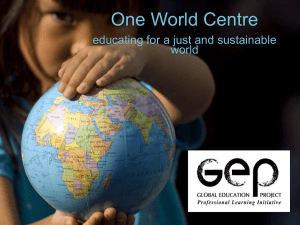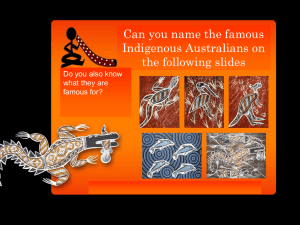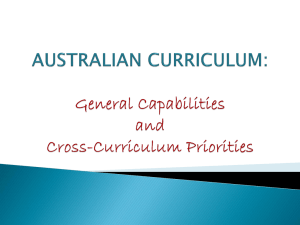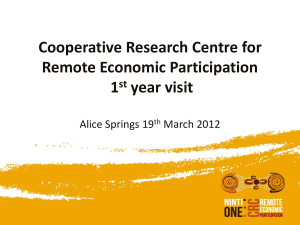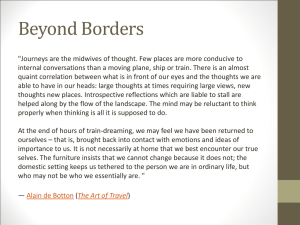Evans - Association of Children`s Welfare Agencies
advertisement
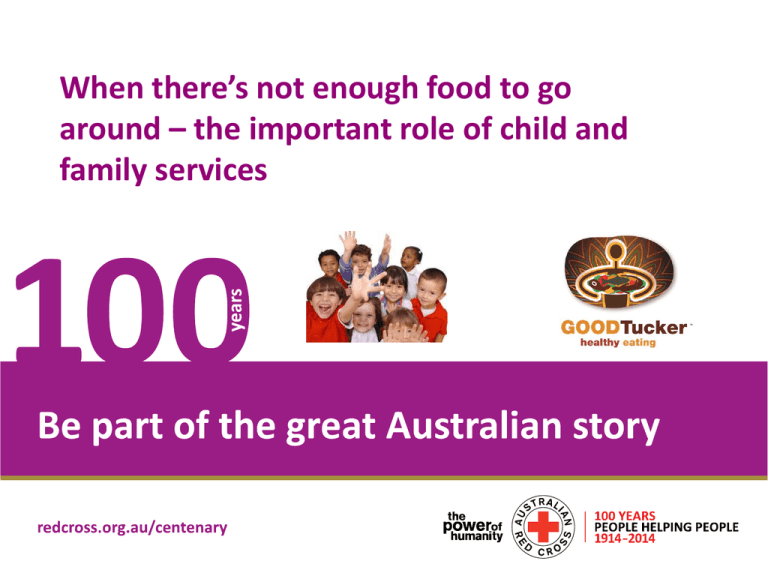
When there’s not enough food to go aroundHeadline – the important role of child and Place here family services Team • Jennifer Evans National Project Lead Child Protection • Renee Gwee National Senior Project Officer Food Security (APD) • Lauren Karklins Case Manager Brisbane North Family Support Program • Joanne McKinnon Project Coordinator Family Support Program Warwick Not just an issue of the past Please Sir I want some more Oliver Twist Charles Dickens 1838 Key Reflections Red Cross experience as an example of process • Building a platform of legitimacy – for children, food security – dialogue/ resources • Understanding the issue • Organisational response • Common characteristics across population groups • What next? Australian Red Cross today Our mission: to improve the lives of vulnerable people in Australia and internationally by mobilising the power of humanity. Our vision: to be a leading humanitarian organisation in Australia, improving the lives of vulnerable people through services delivered and promotion of humanitarian laws and values. Seven Fundamental Principles • Humanity Its purpose is to protect life and health and ensure respect for the human being. It promotes mutual understanding, friendship, co-operation and lasting peace amongst all people. • Impartiality It makes no discrimination as to nationality, race, religious beliefs, class or political opinions. It endeavours to relieve the suffering of individuals, being guided solely by their needs, and to give priority to the most urgent cases of distress. • Neutrality In order to continue to enjoy the confidence of all, the Movement may not take sides in hostilities or engage at any time in controversies of a political, racial, religious or ideological nature. • Independence National Societies, while auxiliaries in the humanitarian services of their governments and subject to the laws of their respective countries, must always maintain their autonomy so that they may be able at all times to act in accordance with the principles of the Movement. • Voluntary service Voluntary relief movement not prompted in any manner by desire for gain • Unity Only one Red Cross or Red Crescent Society in any one country, open to all & carry on its humanitarian work throughout its territory. • Universality IRCRC movement -all Societies have equal status and share equal responsibilities and duties in helping each other Priority Areas Red Cross helps to improve the lives of vulnerable people by working in the following areas: 1. 2. 3. 4. 5. 6. 7. 8. together as partners with Aboriginal and Torres Strait Islander peoples championing international humanitarian law increasing international aid and development tackling entrenched locational disadvantage addressing the impact of migration strengthening national emergency preparedness, response and recovery overcoming social exclusion by providing bridges back into the community providing a safe and secure blood supply for Australians Food Security Definition Food Security is the state of having: regular and sustainable access to safe nutritionally adequate affordable and culturally acceptable food from non-emergency sources. Policy context International Context United Nations Conventions on the Rights of the Child – 25 years Article 6 - “Children have the right to live a full life. Governments should ensure that children survive and develop healthily.” Article 24 – “Children have the right to good quality health care, clean water, nutritious food and a clean environment so that they will stay healthy. Richer countries should help poorer countries achieve this.” United Nations Declaration of Human Rights Article 25 (1) – “Everyone has the right to a standard of living adequate for the health and well-being of himself and of his family, including food, clothing, housing and medical care and necessary social services, and the right to security in the event of unemployment, sickness, disability, widowhood, old age or other lack of livelihood in circumstances beyond his control.” Policy context National Context • Protecting Children is Everyone’s Business (National Policy Framework) • State and Territory Child Protection Legislation • Australian Guide to Healthy Eating • Infant Feeding Guidelines • National Food Plan (2012) Hierarchy of needs Australia’s Children How are they doing? Australia ranks just ‘middle of the road’ in comparison to other Organisation for Economic Cooperation and Development (OECD) countries on indicators of child and youth wellbeing across the key domains of: • Families, health education, child poverty, deprivation and participation One in six young Australians are at risk of neglect and abuse Australia’s children Poverty • OECD report • Relative poverty in Australia (14.4% of the population) is higher than the OECD average (11.3%). Even if they still are high, poverty rates for youth and particularly those over the age of 65 declined, while child poverty increased. • 17% of children are living below the poverty line • 10% of Australians report that they cannot afford to buy enough food. This proportion has increased somewhat over the past years, but remains lower than the OECD average of 13.2%. • Deprivation Index– ability of households to afford essentials • Four items food security Deprivation index of child poverty 14 item deprivation index 1. Three meals a day 2. At least one meal a day with meat, fish or chicken (or a vegetarian equivalent) 3. Fresh fruit and vegetables everyday 4. The opportunity, from time to time to invite friends home to play and eat Measuring child poverty, UICEF, Innocenti Research Centre, Report Card 10, 2012. Australia’s children Poverty • Red Cross Inaugural Vulnerability Report 2013 “After paying the rent we have $35 left for 2 weeks…we are eating noodles and eggs…normally one sometimes two meals a day. We realise this is not good for us…the body is not getting what it needs.” 40% of people seeking asylum had experienced food insecurity in the preceding 12 months, principally because of the cost of household bills and low income • Homelessness • 105, 237 homeless people (0.5% of population) in Australia • 27% 18 years and under Food Poverty (cont’d) • Anglicare report 2013 – Hard Choices: Going Without in a Time of Plenty (A study of Food Insecurity in NSW and ACT of people accessing their emergency relief services) • 3 out of 4 children lived in a food insecure household • In 14% of the households, children were forced to skip meals • In 25% of cases, children were forced to go hungry on a regular basis • In 7% of households, children did not eat for a whole day on a recurrent basis • Sanitarium key news poll findings 2013 • 22% eat less to save money or had no more money • 7% said they do this regularly • 27% households put off paying bills so they can afford food when kids in family Australia’s children Aboriginal and Torres Strait Islander Communities • In 2004-2005, 24% of Indigenous Australians aged 15 years and over reported they ran out of food in the last 12 months, compared to 5% of nonIndigenous Australians • In a 2006 Victorian study 51% of Aboriginal families reported experiencing food insecurity, whereby they ran out of food and were not able to buy anymore • Aboriginal and Torres Strait Islander children are 30 times more likely to suffer from nutritional anaemia as a result of poor nutrition and feeding practices • Aboriginal and Torres Strait Islander children between 2 and 4 years of age are almost twice as likely to be overweight or obese as compared with all Australian children in that age range Browne J, Laurence S, Thorpe S (2009) Acting on food insecurity in urban Aboriginal and Torres Strait Islander communities: Policy and practice interventions to improve local access and supply of nutritious food. Australian Medical Association,. (2013). Aboriginal and Torres Strait Islander Health Report Card 20122013. AMA. Multiple perspectives • Household Perspective • Health impacts • Child development • Social exclusion • Behavioural challenges • Educational challenges • Life events Framework for Food Security Livelihood's concept Food Security Continuum Food secure Food insecure without hunger Rosier K. Food insecurity in Australia: What is it, who experiences it and how can child and family services support families experiencing it? - CAFCA Practice Sheet - Child Family Community Australia [Internet]. Aifs.gov.au. 2013. Available from: http://www.aifs.gov.au/cafca/pubs/sheets/ps/ps9.html Food insecure with severe hunger Translating framework into practice • Individual, and households: case work and group work • Communities; local partnerships, health education, community development and skill sharing • Work force development: training, forums • Resource, Program development : research, desk top reviews • Advocacy: research, partnerships and sector participation Food Literacy “Food literacy can be defined as the relative ability to basically understand the nature of food and how it is important to you and how you are able to gain information about food, process it, analyse it and act upon it.” Vidgen & Gallegos, 2011 Food literacy consists of the following competencies: • Access • Eating • Planning and Management • Selection • Knowing where food comes from • Preparation • Nutrition • Eating • Language Vidgen H &Gallegos D. What is food literacy and does it influence what we eat: a study of Australian food experts. (2011). Queensland University of Technology, Brisbane, Queensland. Australian Red Cross FOODcents® program Six modules: 1. Healthy Eating 2. Food Budgeting 3. Smart Shopping 4. Get Moving 5. Healthy Cooking 6. Kitchen Safety Topics covered in these modules include: • defining a healthy diet and why it’s important; • identify food budgeting problems and solutions; • recipe planning and shopping lists; • finding and cooking low budget recipes; • how to read a nutrition panel and choose health products; • a grocery shopping tour; • tops for recipe modification and increasing fruit and vegetable consumption; • food preparation and cooking methods; • safety and hygiene (food handling and storage); • nutrition through the life-cycle (e.g. early childhood, adolescence, pregnancy, breastfeeding) • understanding food advertising and marketing strategies; • healthy lunch boxes and healthy snacks; Common considerations • Context - understand drivers - lived experiences • Solutions- adapted process and resources • Where and how to work in this space • Engagement and food security issues • Sense of accomplishment – confidence Resources - Program Development: Research Best Practice • • • • • Australian Red Cross FOODcents® program Superfood Heroes Good Tucker Healthy Eating Balcony gardens MSP specific • • • • • National Food security survey Qld focus groups & Healthy Living for Every Culture Taste Australia (NSW) Putting Down Roots (SA, Vic) A New Place to Taste (SA) • Recipes • The Mixing Bowl: Healthy Recipes for One or Two ACT • FOODcents® specific recipes Communities and partnerships • Local • Healthy Baby Healthy Community - Galiwinku with Miwatj Health Aboriginal Corporation • Fregon Emergency Relief program SA • Community Connect Second Bite Vic • Food Rescue organisations eg. Foodbank, Secondbite, OzHarvest • Food mapping Newcastle University and Kempsey LG • Tucker Tracks Multiple agencies in Kempsey • School and community gardens • CALD community resource centres and TAFE in Queensland • State • Food provision outlet mapping and low SE areas; Anglicare ACT SENSW; Low cost and free food information brochure Yellow Van, Health, ACT • Foodbank, Cancer Council WA • OPAL, Foodbank SA Advocacy: Policy $ Partnerships National Dietitians Association Australia and Public Health Association of Australia MOU Academic network of experts Curriculum Development State Fair Food Alliance NSW APY Lands Executive Action Team (APY EAT) Brighton Food Security project: Tasmania SecondBite; The Smith Family; Jordon River Services; the Aboriginal Child and Family Centre; Campbell Page; Good Beginnings and Bridgewater PCYC ACWA What’s next Thank you: ACWA, Anglicare, QUT, Curtin University • Invitation to each of you to go back to your organisations and teams and start a conversation about the role of food security in your everyday practice with children and families, implications for foster care training, opportunities for partnerships and advocacy. • Further learning opportunities: NSW conference “Putting Food on the Table” October • Interest to convene a practice discussion …if organisations are interested, please email us References – food security Browne J, Laurence S, Thorpe S (2009) Acting on food insecurity in urban Aboriginal and Torres Strait Islander communities: Policy and practice interventions to improve local access and supply of nutritious food. Dowler, E., & O’Connor, D. (2012). Rights-based approaches to addressing food poverty and food insecurity in Ireland and UK. Social Science & Medicine, 74(1), 44--51. King, S., Bellamy, J., Kemp, B., & Mollenhauer, J. (2013). Hard choices (1st ed.). Parramatta, N.S.W.: ANGLICARE Diocese of Sydney. McCurdy, K., Gorman, K., & Metallinos-Katsaras, E. (2010). From poverty to food insecurity and child overweight: a family stress approach. Child Development Perspectives, 4(2), 144--151. Vidgen, H., & Gallegos, D. (2011). What is food literacy and does it influence what we eat: a study of Australian food experts. Queensland University Of Technology. Whitbeck, L., Chen, X., & Johnson, K. (2006). Food insecurity among homeless and runaway adolescents. Public Health Nutrition, 9(01), 47--52. References – Children & Family Welfare Australian Centre for Child Protection. (2014). Protecting and Nurturing Children: Building Capacity, Building Bridges (BCBB) - Research - University of South Australia Australian Medical Association, The Healthy Early Years – Getting the Right Start in Life, Indigenous Health Report Card, 2013, Australia Australian Research Alliance for Children and Youth, Report Card: The wellbeing of young Australians.2013. Australia Australian Government 2013. A Snapshot of Early Childhood Development in Australia 2012 — AEDI National Report, Australian Government, Canberra. Scott, D. (2009). 'Think Child, Think Family': How Adult Specialist Services Can Support Children at Risk of Abuse and Neglect. Family Matters, (81), 37. Homelessness Task Force. The Road Home: A National Approach to Reducing Homelessness. Canberra: Department of Families, Housing, Community Services and Indigenous Affairs, 2008 Recommended links Information • • • • • Australian Red Cross Inaugural Vulnerability Report http://www.redcross.org.au/files/ARC_VulnerabilityReport_LR.PDF Australian Red Cross FOODcents® program (Western Australia) http://www.foodcentsprogram.com.au/ Good food for new arrivals (http://nutrition.asetts.org.au/) Nutrition Education Materials Online (Queensland Health) http://www.health.qld.gov.au/nutrition/nemo_general.asp Better Health Channel - State of Victoria http://www.betterhealth.vic.gov.au/ Food rescue/ low cost food options including food cooperatives: • Foodbank • Oz Harvest, • Second Bite , • Yellow Van (ACT) “Lived poverty is the embodiment of hard choices. Households living on the margins experience significant levels of deprivation as they choose between having sufficient food to feed their families, securing stable and affordable accommodation and paying utility and medical bills. The experience can be one of isolation and social disconnection from family and friends, and a significant struggle to protect their children from the worst effects of such poverty.” ANGLICARE, 2013 Contact Jennifer Evans National Project Lead Child Protection Ph: (02) 9229 4269 jeevans@redcross.org.au Red Cross National Food Security Team natfoodsecurity@redcross.org.au Food Insecurity Protecting Children is Everyone’s Business • Joined up responses • Placed based approaches • Role of adult facing services – child aware/child and family sensitive practice • Drug & Alcohol, Mental Health, homelessness
